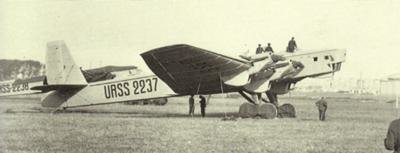When the first sample of the TB-3, a low wing, four engine heavy bombers made its maiden flight in the morning of December 22nd 1930, it became the most advanced piece of machinery ever to grace the skies. The USSR’s Red Air Force was so impressed with the aircraft’s handling ability and massive payload capacity, that it only took two test flights before the TB-3 went into full production mode.
Because it carried more payload than anything flying at the time, the TB-3’s fuselage was designed with reinforced steel bars in all sections. The airframe structure was very similar to the ones utilized by the German aircraft manufacture Junkers. The wings were very thick. In fact, the bomber used a system of crawl ways to give crew access to the engine areas during flight.
As advanced as the TB-3 was, it still employed several “old fashion” structures. Chief among them was the open cockpit. The pilot and co-pilot sat in a side-by-side configuration separated only by a rudimentary windscreen.
In all, almost 500 TB-3s, in various versions, were produced. Unfortunately for the USSR, the TB-3 was the Red Army Air Force’s main night attack platform during the early days of Operation Barbarossa in 1941. Outdated and outclassed by the time of Barbarossa, the TB-3 did carry out interdiction sorties but at an enormous price. Soon after, the bomber was removed from front line service. Although outclassed as a bomber, the TB-3 did made a useful contribution to the Red Army war effort as a troop transporter.
Power Plant: Four 715hp M17F Piston Engines
Wingspan: 39.5m
Length: 24.4m
Height: 8.2m
Total Wing Area: 230m2
Maximum Takeoff Weight: 17,200 kg
Top Speed: 197kph
Operational Ceiling: 3,800m
Range: 1,350km
Armament: Eight 7.7mm heavy machine guns (nose and dorsal positions) Two retractable underwing dustbins for total bomb capacity of 2,000 kg
